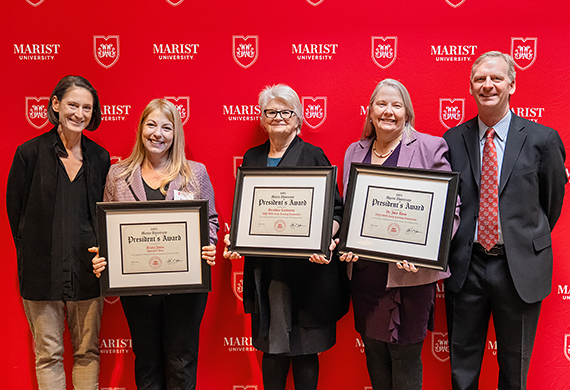The Center for Social Media is Helping Students Learn to Listen

The hallmark of Marist’s School of Communication and the Arts is how it successfully blends a strong liberal arts academic core and pre-professional training. To maintain this balance, Dean Lyn Lepre and her colleagues continually solicit feedback from alumni, faculty, and students to learn how to best prepare students for the workforce. This approach is complemented by formal research into the job market.
Early on, Lepre recognized the market demand for students with mastery of social media marketing practices, and she knew it was crucial for Marist to expand its offerings to fill this gap. Although some faculty were already teaching these topics in class, Lepre felt strongly that this area cannot just be discussed – it needs to be practiced, too. Said Lepre, “We needed to turn students from native users into strategic experts, teach them analytical and data-listening skills, and provide them with real-world, digital marketing expertise.”
Powering the Center for Social Media with Social Studio
With this in mind, Lepre and her team launched the Center for Social Media in 2017 with the goal of educating students in industry-leading practices in social media listening, engagement, influence, and analytics. Located on the main level of Lowell Thomas, this co-curricular center has a fully furnished space with two computers and seven large screens for students and faculty to use when creating and analyzing social media content.
Colleen Kopchik (left) with students in the Center for Social Media
After extensive review and consultation with communication faculty members, Lepre selected the cloud-based software company Salesforce to power the Center. Said Lepre, “We selected Social Studio, which includes Command Center, for two primary reasons: Social Studio is widely used in the industry, and it was the only product out of the seven we reviewed that allowed students and faculty to listen and engage with external digital content from one billion data sources, spanning social media, news, and aggregators.”
Colleen Kopchik, inaugural director of the Center for Social Media, was impressed with the combined power of Social Studio (the engine that enables the listening, engaging and publishing of social media marketing) and Command Center (the visual display of all social media activity). “The combination of these tools provides our users with real-time data in an attractive and useful visual interface that can be viewed both at the physical Center for Social Media and anywhere in the world. It offers extensive and powerful publishing and engagement options, ranks the sentiment of external content for student and faculty analysis, and provides performance metrics for social content created.”
Extending social media within the classroom and beyond
As word of mouth about the Center for Social Media spread, faculty and students became aware of the many opportunities to incorporate Social Studio into coursework – across disciplines – by conducting research and executing social media campaigns for co-curricular activities and local nonprofits. In the first year, faculty and students utilized the Center for Social Media for student- and faculty-sponsored workshops on topics such as awareness of one’s digital footprint; a senior thesis project on self-promotion and branding; a graduate online capstone course in integrated marketing communication that analyzed the branding capabilities of a nationwide product and how it could better reach a younger, digitally-focused audience; faculty and student research using primary social media data; student-launched digital marketing campaigns; and real-time analysis for a campus speaker series and Marist’s annual fashion show.
These dynamic, hands-on opportunities have served to broaden Marist students’ experiences with social media and digital marketing. Kopchik remarked, “Not only are we giving students the data piece of social media, we’re giving them the ability to learn how to manage active social media pages as well.” Lepre and Kopchik surveyed the graduate capstone course that used Social Studio and found that 80 percent of these students would like to use it in their other classes. “This reinforced that we’re going
down the right path,” said Kopchik. “This is something our students want, something our students need, and something that we need to be providing.”
Broadening the social media experience for students and faculty
Interest in the Center for Social Media continues to grow as more faculty and students use Social Studio in academic and co-curricular work. Many courses in the School of Communication and the Arts use Social Studio either as a required or optional tool. In addition, Marist’s in-house student-run communications firm, North Road Communications, uses Social Studio to analyze and create digital marketing campaigns for local nonprofit organizations.
Lepre and Assistant Professor of Communication Amanda Damiano (the Center’s current director) look forward to expanding the Center for Social Media’s presence, both on the Marist campus and internationally. Other departments at the College are now evaluating how to utilize Social Studio in a range of new projects. Additionally, Lepre and Damiano anticipate more use of Social Studio among international students at Marist’s Florence campus and in other locations. A few students abroad have already utilized the platform to conduct communications analysis and social media campaigns in other countries. “We are excited that we can use this anywhere in the world,” said Lepre. “Students can take it with them.” And, best of all, they will take their new skills with them to the job market after graduation.
School of Communication and the Arts Dean Lyn Lepre



